
Sec. 11401. Infrastructure bill Grants for charging and fueling infrastructure.
Share
Section 11401 directs the Secretary to establish a grant program for Alternative Fuel Corridors, as well as a set-aside grant program for Community grants. These programs are designed to strategically deploy publicly accessible electric vehicle charging infrastructure, hydrogen fueling infrastructure, propane fueling infrastructure, and natural gas fueling infrastructure along designated alternative fuel corridors or in certain other locations that will be accessible to all drivers of electric vehicles, hydrogen vehicles, propane vehicles, and natural gas vehicles. Eligible entities include a State or political subdivision of a State, a metropolitan planning organization, a unit of local government, a special purpose district or public authority with a transportation function, including a port authority, an Indian tribe, and a territory of the United States. Section 1401 would also amend section 151 of title 23 to make the process of designating alternative fuel corridors periodic and recurring, and also modifies a reporting deadline.
Eligible entities under the program are all public entities and are comprised of a State or political subdivision of a State; an MPO; a unit of local government; a special purpose district or public authority with a transportation function; an Indian tribe; an authority entity, agency, or instrumentality of, or an entity owned by, 1 or more of the preceding eligible entities; and a group of the preceding eligible entities.
Applications must include a description of how the eligible entity has considered public accessibility relative to the proposed project, collaborative engagement with stakeholders, the location of the proposed project, responsiveness to technology advancements, and the long-term operation and maintenance of the proposed project.
In selecting eligible entities to receive grants, the Secretary must consider whether an application would improve alternative fueling corridor networks, meet the current or anticipated market for charging or alternative fueling infrastructure, enable or accelerate the construction of charging or alternative fueling infrastructure that would be unlikely to be completed without Federal assistance, and support a long- term competitive market for alternative fueling and charging infrastructure. Additionally, the Secretary must consider geographic diversity among applicants, the finances and experience of private entity contractors, and the adequacy of agreements between eligible entities and their private entitycontractors.
Grants for the alternative fuel corridors are to be used to contract with a private entity for acquisition and installation of publicly accessible alternative fuel vehicle charging and fueling infrastructure that is directly related to the charging or fueling of a vehicle. Such infrastructure is to be located along an alternative fuel corridor either designated under section 151, or by a State or group of States on the condition that any affected Indian tribes are consulted before the designation. Eligible entities may use a portion of grant funds to provide a private entity operating assistance for the first 5 years of operations after infrastructure installation.
Eligibility includes propane fueling infrastructure, but limits it to infrastructure for medium- and heavy- duty vehicles.
50 percent of the total program funds will be made available each fiscal year for Community Grants, to install EV charging and alternative fuel in locations on public roads, schools, parks, and in publicly accessible parking facilities. These grants will be prioritized for rural areas, low-and moderate income neighborhoods, and communities with low ratios of private parking, or high ratios of multiunit dwellings.
The Federal cost-share for a project may not exceed 80 percent. Further, as a condition of contracting with an eligible entity, a private entity must agree to pay the non-Federal share of project costs.
This program creates the federal program foundation for low or zero-emission fueling of vehicles
including Electric Vehicles and other non-ICE vehicles.
